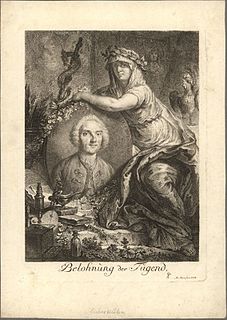
A microscope is a laboratory instrument used to examine objects that are too small to be seen by the naked eye. Microscopy is the science of investigating small objects and structures using a microscope. Microscopic means being invisible to the eye unless aided by a microscope.

Trapani is a city and municipality (comune) on the west coast of Sicily, in Italy. It is the capital of the Province of Trapani. Founded by Elymians, the city is still an important fishing port and the main gateway to the nearby Egadi Islands.

A theodolite is a precision optical instrument for measuring angles between designated visible points in the horizontal and vertical planes. The traditional use has been for land surveying, but they are also used extensively for building and infrastructure construction, and some specialized applications such as meteorology and rocket launching.

A refracting telescope is a type of optical telescope that uses a lens as its objective to form an image. The refracting telescope design was originally used in spy glasses and astronomical telescopes but is also used for long focus camera lenses. Although large refracting telescopes were very popular in the second half of the 19th century, for most research purposes, the refracting telescope has been superseded by the reflecting telescope, which allows larger apertures. A refractor's magnification is calculated by dividing the focal length of the objective lens by that of the eyepiece.

A reflecting telescope is a telescope that uses a single or a combination of curved mirrors that reflect light and form an image. The reflecting telescope was invented in the 17th century by Isaac Newton as an alternative to the refracting telescope which, at that time, was a design that suffered from severe chromatic aberration. Although reflecting telescopes produce other types of optical aberrations, it is a design that allows for very large diameter objectives. Almost all of the major telescopes used in astronomy research are reflectors. Reflecting telescopes come in many design variations and may employ extra optical elements to improve image quality or place the image in a mechanically advantageous position. Since reflecting telescopes use mirrors, the design is sometimes referred to as a "catoptric" telescope.

Museo Galileo, the former Istituto e Museo di Storia della Scienza is located in Florence, Italy, in Piazza dei Giudici, along the River Arno and close to the Uffizi Gallery. The museum, dedicated to astronomer and scientist Galileo Galilei, is housed in Palazzo Castellani, an 11th-century building which was then known as the Castello d’Altafronte.

The Museum of Zoology and Natural History, best known as La Specola, is an eclectic natural history museum in Florence, central Italy, located next to the Pitti Palace. The name Specola means observatory, a reference to the astronomical observatory founded there in 1790. It now forms part of the Museo di Storia Naturale di Firenze. This museum is part of what are now six different collections at four different sites for the Museo di Storia Naturale di Firenze.

Johann Nathanael Lieberkühn was a German physician. His middle name is sometimes misspelled Nathaniel.

The Museo Correr is a museum in Venice, northern Italy. Located in St. Mark's Square, Venice, it is one of the 11 civic museums run by the Fondazione Musei Civici di Venezia. The museum extends along the southside of the square on the upper floors of the Procuratorie Nuove. With its rich and varied collections, the Museo Correr covers both the art and history of Venice.

A telescope is an optical instrument using lenses, curved mirrors, or a combination of both to observe distant objects, or various devices used to observe distant objects by their emission, absorption, or reflection of electromagnetic radiation. The first known practical telescopes were refracting telescopes invented in the Netherlands at the beginning of the 17th century, by using glass lenses. They were used for both terrestrial applications and astronomy.

Museo Nazionale Scienza e Tecnologia Leonardo da Vinci in Milan is the largest science and technology museum in Italy, and is dedicated to Italian painter and scientist Leonardo da Vinci. It was opened on 5 February 1953 and inaugurated by the prime minister of Italy, Alcide De Gasperi.

Changchun University of Science and Technology is a key university in Changchun, Jilin, China, previously known as Changchun Institute of Optics and Fine Mechanics. It was founded by Wang Daheng in 1958.

The Byzantine lyra or lira was a medieval bowed string musical instrument in the Byzantine Empire. In its popular form, the lyra was a pear-shaped instrument with three to five strings, held upright and played by stopping the strings from the side with fingernails. The first known depiction of the instrument is on a Byzantine ivory casket, preserved in the Bargello in Florence. Versions of the Byzantine lyra are still played throughout the former lands of the Byzantine Empire: Greece, Crete, Albania, Montenegro, Serbia, Bulgaria, North Macedonia, Croatia, Italy and Armenia.

The Museo internazionale e biblioteca della musica is a music museum and music library in the Palazzo Aldini Sanguinetti, in the historic center of Bologna, Italy.

Georg Merz was a Bavarian optician and manufacturer of astronomical telescopes and other optical instruments.

Ibrahim Ibn Saîd al-Sahlì was an Andalusian globe-maker, active from 1050 to 1090.
Louis Chapotot was a French scientific instrument maker.
Edmund Culpeper (1660–1738) was an English scientific instrument maker.
The Campani compound microscope is a microscope on exhibit at the Museo Galileo in Italy, thought to have been built by optical instrument maker Giuseppe Campani in the second half 17th century. For a time it was thought to have been built by Italian scientist Galileo Galilei but no longer bares that attribution.















